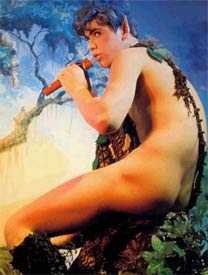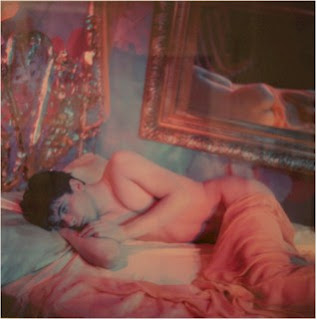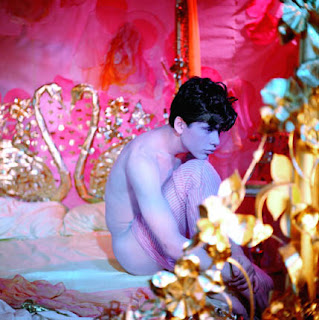Ali, S, Campbell, K, Branley, D and James, R (2006). ‘Politics, identities and research.’ In: Seale, C, ed. (2006),
Researching Society and Culture. London: Sage.
Althaus-Reid, Marcella (2003).
The Queer God. London: Routledge.
Becker-Huberti, Manfred (undated),
Aussehen wie die Heilige Kümmernis: über eine erfundene „Heilige”. [online] Available from:
http://www.religioeses-brauchtum.de/sommer/heilige_kuemmernis.html [Accessed: 30/4/2007]
Blackwood, E and Wieringa SE (2001). ‘Sapphic Shadows: Challenging the Silence in the Study of Sexuality.’ In: Juschka, Darlene M., ed. (2001),
Feminism in the Study of Religion: a Reader. London and New York: Continuum.
Blain, J (2002).
Nine Worlds of Seid-Magic: Ecstasy and Neo-Shamanism in North European Paganism. London and New York: Routledge.
Boisvert, D (1999). ‘Queering the Sacred: Discourses of Gay Male Spiritual Writing.’
Theology and Sexuality 10, pp 54-70.
Bourne, Lois (1979),
A Witch Amongst Us. London: Satellite.
Cherry, Kittredge (2006),
Jesus in Love. Berkeley: AndroGyne Press.
Conner, Randy P., Sparks, David Hatfield, and Sparks, Mariya (1997),
Cassell’s Encyclopedia of Queer Myth, Symbol and Spirit. London and New York: Cassell.
Dewr, C (1998).
Why Pagan Pride? [online] Available from:
http://www.paganpride.org/what/why.html accessed 5-5-2007
Duncan, Hal (2007),
The Protocols of the Elders of Sodom. [online] Available from:
http://notesfromthegeekshow.blogspot.com/2007/01/protocols-of-elders-of-sodom.html Accessed 2/5/2007
Duncan, Hal (2005),
The Homosexual Agenda.
http://notesfromthegeekshow.blogspot.com/2007/01/protocols-of-elders-of-sodom.html Accessed 2/5/2007
Foltz, TG (2000). ‘Sober Witches and Goddess Practitioners: Women’s Spirituality and Sobriety.’
Diskus, 6: 1. [online] Available from:
http://web.uni-marburg.de/religionswissenschaft/journal/diskus/foltz.html Accessed 3-5-2007
Ford, Thomas Michael (2005),
The Path of the Green Man: Gay Men, Wicca and Living a Magical Life. New York: Citadel Press.
Foster, N (undated).
A Prayer in the Dark. Available from: Lesbian and Gay Christian Movement. [
http://www.lgcm.org.uk/archive/archive4a.html] Accessed 27-03-2007.
Foucault, M (1978).
The History of Sexuality Volume 1: An Introduction. Trans. Hurlet, R. Harmondsworth: Penguin Books.
Francis-Dehqani, GE (2004). ‘The Gendering of Missionary Imperialism: The Search for an Integrated Methodology.’ In: King, U. and Beattie, T. (2004),
Gender, Religion and Diversity: Cross-Cultural Perspectives. London and New York: Continuum.
Gill, S (2004). ‘Why difference matters: Lesbian and gay perspectives on religion and gender.’ In: King, U. and Beattie, T. (2004),
Gender, Religion and Diversity: Cross-Cultural Perspectives. London and New York: Continuum.
Goss, RE (1999). ‘Queer Theologies as Transgressive Metaphors: New Paradigms for Hybrid Sexual Theologies.’
Theology and Sexuality, 10: pp 43-53. Available from Ebscohost. Accessed 26-03-2007.
Gross, RM (2004). ‘Where have we been? Where do we need to go?: Women’s studies and gender in religion and feminist theology.’ In: King, U. and Beattie, T. (2004),
Gender, Religion and Diversity: Cross-Cultural Perspectives. London and New York: Continuum.
Hart, L (2005).
Magic is a many-gendered thing. [online] Available from:
http://www.philhine.org.uk/writings/flsh_gendered.html Accessed 17-05-2007
Hawley-Gorsline, R. (1996). 'Facing the Body on the Cross: A Gay Man’s Reflections on Passion and Crucifixion'. In: Krondorfer, B, ed. (1996).
Men’s Bodies, Men’s Gods: Male Identities in a (Post-) Christian Culture. New York and London: New York University Press.
Hawley-Gorsline, R. (2003). 'James Baldwin and Audre Lorde as Theological Resources for the Celebration of Darkness.'
Theology and Sexuality 10.1 (2003) 58-72 Available from: Ebscohost. Accessed 26-03-2007.
Haxton, N (2003).
Adelaide hosts first ever Queer Spirituality Festival. [online] Available from:
http://www.abc.net.au/am/content/2003/s995098.htm Accessed: 3-5-2007
Hine, P (1989).
Some musings on polarity. [online] Available from:
http://www.philhine.org.uk/writings/flsh_polarity.html Accessed 17-5-2007
Hoff, BH (1993).
Gays: Guardians of the Gates. An interview with Malidoma Somé. Online, available from
http://www.menweb.org/somegay.htm Accessed 6-5-2007
Holland, V (1985 [1948]). 'Introduction.'
In: The Complete Works of Oscar Fingal O’Flahertie Wills Wilde: Stories, Plays, Poems, Essays. London and Glasgow: Collins.
Hutton, Ronald (1999),
The Triumph of the Moon: a history of modern Pagan witchcraft. Oxford: Oxford University Press.
Juschka, Darlene M., ed. (2001),
Feminism in the Study of Religion: a Reader. London and New York: Continuum.
Lamond, F (1997),
Religion without Beliefs: Essays in Pantheist Theology, Comparative Religion and Ethics. London: Janus Publishing Company.
Landstreet, L (1999 [1993]),
Alternate Currents: Revisioning Polarity Or, what’s a nice dyke like you doing in a polarity-based tradition like this? http://www.witchvox.com/va/dt_va.html?a=usxx&c=gay&id=2458 online, accessed 5-5-2007
Marcadé, Bernard, and Cameron, Dan (1997),
Pierre et Gilles: The Complete Works, 1976-1996. Paris: Taschen.
Matthieu, N-C (1996). ‘Sexual, Sexed and Sex-Class Identities: Three Ways of Conceptualising the Relationship between Sex and Gender.’
In: Leonard, D & Adkins, L, eds.
Sex in Question: French Materialist Feminism. London: Taylor and Francis.
Moon, T (2005). 'Spirit Matters IV: Ten Queer Spiritual Roles.'
San Francisco Bay Times. [online] Available from:
http://www.sfbaytimes.com/index.php?sec=article&article_id=3772 Accessed 30-4-2007.
Moore, SD (2001).
God’s Beauty Parlor and other queer spaces in and around the Bible. Stanford: Stanford University Press.
Odih, P (2006). ‘Using the Internet.’
In: Seale, C, ed. (2006),
Researching Society and Culture. London: Sage.
Owen, Alex (2004),
The Place of Enchantment: British Occultism and the Culture of the Modern. Chicago: The University of Chicago Press.
Prosser, J. (1998).
Second Skins: The Body Narratives of Transsexuality. New York, Columbia University Press.
Reid-Bowen, P (2007).
Goddess as Nature: Towards a Philosophical Thealogy. London: Ashgate Publishing.
Roberts, Michèle (1984),
The Wild Girl. London: Methuen.
Rodgers, B (1995), 'The Radical Faerie Movement: A Queer Spirit Pathway'.
Social Alternatives, 14:4 pp 34-37. Available from Ebscohost, Academic Search Elite [
http://web.ebscohost.com/ehost/detail?vid=7&hid=107&sid=4e1e546d-c434-4a6e-a38e-72cd4de849d7%40sessionmgr107]. Accessed 27-03-2007.
“Mama Rose” (undated).
Why go Dianic? http://www.iit.edu/~phillips/personal/philos/dianic.html Accessed 3-5-2007
Saadaya (undated).
Coming Out as a Rite of Passage.
http://www.angelfire.com/journal/saadaya/ComingOut.html Accessed 3-5-2007
Sawyer, D. (2004). ‘Biblical Gender Strategies: The Case of Abraham’s Masculinity.’
In: King, U. and Beattie, T. (2004),
Gender, Religion and Diversity: Cross-Cultural Perspectives. London and New York: Continuum.
Schüssler Fiorenza, Elizabeth (1992 [1983]),
In Memory of Her: A Feminist Theological Reconstruction of Christian Origins. New York: Crossroads.
Seale, C. (2006). ‘History of Qualitative Methods.’
In: Seale, C, ed. (2006),
Researching Society and Culture. London: Sage.
Seneviratne, T and Currie, J (2001). 'Religion and Feminism: A Consideration of Cultural Restraints on Sri Lankan Women.'
In: Juschka, Darlene M., ed. (2001),
Feminism in the Study of Religion: a Reader. London and New York: Continuum.
Standing, E (2004), ‘Homophobia and the Postmodern Condition.’
Theology and Sexuality 10.2 pp 65-72
Starhawk, Nightmare, MM, and the Reclaiming Collective (1997).
The Pagan Book of Living and Dying: Practical Rituals, Prayers, Blessings and Meditations on Crossing Over. San Francisco: HarperSanFrancisco.
Stemmeler, ML (1996). ‘Empowerment: the Construction of Gay Religious Identities.’
In: Krondorfer, B, ed. (1996).
Men’s Bodies, Men’s Gods: Male Identities in a (Post-) Christian Culture. New York and London: New York University Press.
Stuffed Animal (2006),
How I see Jesus Christ.
http://christthegaymartyr.blogspot.com/2006/03/how-i-see-jesus-christ.html Accessed 2/5/2007
Summerskill, B (2006), ed.
The Way we are now: Gay and Lesbian Lives in the 21st Century. London and New York: Continuum.
Tatchell, P (2001).
Equality is Not Enough.
http://www.petertatchell.net/Equality%20-%20Limits%20and%20Deficiencies/equality%20is%20not%20enough2.htm [online] accessed 3-4-2007
Taylor, Philip (1998), 'Edward Carpenter Biographical Note'.
The Edward Carpenter Archive,
http://www.edwardcarpenter.net/ecbiog.htm [Accessed 30/04/2007]
Wallis, RJ (2003).
Shamans / Neo-shamans: Ecstasy, alternative archaeologies and contemporary Pagans. London and New York: Routledge.
Walsh, D (2006). ‘Doing Ethnography.’
In: Seale, C, ed. (2006),
Researching Society and Culture. London: Sage.
Wilde, Oscar (1996 [1905]),
De Profundis. New York: Dover Publications, Inc.
Yip, A K T (2003). ‘Spirituality and Sexuality: An Exploration of the Religious Beliefs of Non-Heterosexual Christians in Great Britain.’
Theology and Sexuality, 9: 2 pp 137-154. Available from Ebscohost, Academic Search Elite, accessed 30-4-2007






